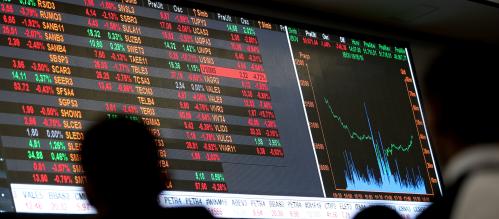The Latin American Committee on Macroeconomic and Financial Issues (CLAAF) is composed of a group of prestigious independent Latin American economists, former policymakers, and academics with strong expertise in the field of macroeconomics, banking and finance and whose goal is to identify and analyze challenges and risks for the region (see a full list of committee members). The following document—Policy Statement Number 38—was released following the meeting held in Buenos Aires, Argentina, on December 14.
After the slowdown of the Chinese economy and the sharp decrease in commodity prices, the Latin American macroeconomic outlook has worsened substantially in relation to the boom that occurred between 2003 and 2012, despite favorable external conditions characterized by significantly high liquidity in international capital markets and a strong economic recovery in developed nations.
In this context, Latin America has shown very low growth rates. Even though growth acceleration is expected, regional unemployment continues to increase. Brazil’s economy is showing a moderate recovery since the deep recession between 2015 and 2016, however, it continues to show significant signs of weakness. Colombia, Mexico, and Peru have also experienced relatively low economic growth rates and Chile, traditionally a very dynamic country, has experienced a growth decline to 1.4 percent in 2017. Argentina’s economy, after many years of stagnation, and as a result of a change in government, has begun to show promising signals of improvement.
A long-standing regional weakness has been a low savings rate. Even in this period of historically favorable exchange rates, the region is experiencing twin deficits (that is, current and fiscal accounts). This limits the capacity to take advantage of the window of opportunity offered by high international liquidity for financing beneficial long-term investment projects, especially in infrastructure.
Macro-Financial Challenges Facing Latin America
The committee believes that in the current context there are external and domestic risk factors that require the attention of those responsible for the economic policy in emerging economies and in the region in particular. It is important to note that in recent years the low levels of international interest rates, the result of expansionary monetary policies in advanced economies, may have fueled an underestimation of the existing risks in capitals markets.
In particular, debt issuance in emerging markets, both in the public and private sectors, has been increasing significantly. Debt issuance in emerging markets in the last year reached 870 billion dollars, drawing attention to an exponential increase with respect to the 350 billion dollars issued in 2015. The same phenomenon was observed in Latin America, where debt issuance increased from 100 billion dollars in 2015 to 200 billion dollars annually in mid-2017.
Some of the recent debt issuances are suggestive of a capital market with a high risk tolerance. Emerging countries with diverse foundations, with differing prospects and conditions, and in some cases low credit ratings, are having resounding success in their international bond issuances. For instance, Ivory Coast sold bonds in international markets amid a military riot, Ukraine sold its first bond since the annexation of Crimea with demand that was three times greater, Nigeria issued a bond with a historically long duration, and Iraq issued a bond whose demand was six times greater than what was offered.
A possible explanation for the rapid expansion in debt issuances of emerging economies is that given the expectation of monetary policy normalization in the U.S. and the eurozone, several countries are trying to secure favorable conditions for their financing and, therefore, are pre-financing part of their future needs. This, for example, could be the case in countries whose stocks of international reserves have increased.
However, a worrying symptom is that the rapid growth of public and private debt issuances has occurred alongside an economic slowdown in many emerging countries that could bring growth to a persistently low level.
At a global level, the persistence of negative real interest rates (and in some cases nominal) in advanced economies has driven a strong expansion of global equity indexes. Another dimension of the low cost of financing is the new wave of leverage in advanced economies, which has motivated expressions of concern by the Bank of International Settlements as well as some central banks. This type of phenomenon occurred in the years prior to the crisis in the real estate markets, where the low cost of indebtedness boosted a fictitious increase in property prices. In this context, even the rapid growth in the value of bitcoin does not seem foreign to this phenomenon.
These developments in international capital markets suggest that the effects of the normalization of monetary policies in the U.S. and the European Union, which will be accompanied by an increase in international interest rates, may be underestimated by financial markets and those responsible for economic policy.
Volatile and disruptive events in capital markets can also occur because of other external factors. First, although the risks of a significant increase in trade protectionism have been reduced, the U.S. economy continues to generate potential risks for emerging economies. In particular, the tax reform currently under consideration suggests that the U.S. may be moving toward an expansionary fiscal policy combined with a more contractionary monetary policy. This combination of policies in the past has been associated with higher interest rates and a strengthened dollar.
Moreover, a significant reduction in the corporate tax rate in the U.S. can lead to a shift in capital flows to this region, further contributing to the dollar’s appreciation. The committee believes that this phenomenon may adversely affect commodity prices.
Although the risk of increased protectionism has diminished, the potential of complications arising in the NAFTA negotiation reforms cannot be ruled out. This risk, which directly affects Mexico, and indirectly affects the region, can become more real depending on how Mexican policy is able to change the current outlook.
The committee also believes that the Chinese economy will continue to have an important influence on the external conditions that the region faces. On the one hand, there are clear signs that China is entering a period of slowdown in its economic growth. On the other hand, the Chinese financial sectors are under a transformation process that has led to domestic deleveraging and a reduction of China’s capital flows abroad. Like the risk factors previously described, these developments can adversely affect commodity prices and the terms of trade of several Latin American and African economies.
Considering these external risk factors, the committee believes that there are elements that make the region more resilient than in the past. In particular, the greater exchange rate flexibility helps to mitigate the effects of an appreciation of the dollar in international markets, although it does not eliminate the risks associated with dollarized debt. The committee believes that the region’s international reserves position is significantly stronger than in the past and provides a significant mitigation factor for the risks described. The committee also emphasizes that the region has increased the composition of its capital inflows toward a greater weight for foreign direct investment in relation to debt, although this trend has begun to revert in recent years.
Even so, the committee believes that the main domestic risk in Latin America is without a doubt the increasing fiscal deterioration experienced by a significant number of countries, particularly in South America, where the median fiscal deficit as a percent of GDP increased by more than 5 percentage points between 2011 and 2017. The fiscal deficit exceeds 6 percent of GDP in Argentina, Brazil, and Ecuador, and is in the range of 3 to 4 percent of GDP in Chile, Colombia, and Uruguay. Mexico and Peru stand out because of their relatively stronger fiscal positions.
As a consequence of the deterioration of the fiscal position, levels of public debt have also increased to potentially alarming levels. Even in the presence of low international interest rates, the ratio of gross public debt to GDP exceeds 60 percent in Latin America as a whole. The ratio of public debt to GDP exceeds 80 percent in Brazil; 60 percent in Uruguay; and is around 50 percent in Argentina, Colombia, and Mexico. Moreover, a significant part of public debt is at a variable rate, which is why an increase in the international interest rate would have an adverse and immediate fiscal impact. Venezuela has already entered a suspension of payments.
In some countries in the region, fiscal weakness also coexists with a substantial increase in the indebtedness of the private sector. Particularly in cases where there are high levels of dollarization and short-term private debt, strong contingencies on the public sector can be generated.
The committee emphasizes that historical experience shows that sustainable levels of debt in emerging economies are much lower than those that apply to advanced economies. In this regard, the committee believes that it is a mistake to make the comparison with advanced economies in terms of the levels of public debt currently experienced. In situations of potential volatility and in the absence of the capacity to issue reserve currencies, there are analyses that suggest that emerging economies may face financial difficulties at levels of public and private external debt as low as 40 percent of GDP, which is the situation the region is currently in. In the committee’s view, this level of indebtedness cannot be justified as the natural result of a countercyclical policy, since the region is possibly undergoing a transition to a lower potential growth level.
Implications for the G-20 Debate
The region currently faces two major challenges. The first is systemic risks to its macroeconomic stability, and the second is unsatisfactory growth rates. This has important implications for two core areas on the G-20 agenda.
On the one hand, it is necessary to develop effective instruments and mechanisms so that the international community responds adequately to potential situations of international financial instability. On the other hand, given the significant necessity that Latin America must increase its investments in infrastructure projects, it is a priority to develop new financing instruments for this type of project and to strengthen and modernize the role of the multilateral development bank.
Reforms to the international financial architecture
The committee believes that the recovery of the global economy after the last financial crisis is a propitious moment to rethink the response mechanisms of the official international community to new potential situations of volatility in the international capital markets. This is particularly important in the event that any systemic financial disruption directly affects emerging markets. In this sense, the systemic crisis response experience has been evolving from the 1990s until the most recent global financial crisis. The response instruments have evolved from conditional loans, to the provision of liquidity, to instances of liability restructuring. The committee believes that mechanisms for responding to systemic crises must be explicitly stated and elaborated in greater detail. It is particularly important that clear response principles are developed to limit situations of contagion.
In this context, the committee believes that the instruments at the International Monetary Fund’s disposal are insufficient and require reformulation, particularly the Flexible Credit Line (FCL). The FCL of the IMF is a cheap instrument of liquidity provision without conditionalities, of which a significant number of emerging countries and particularly Latin American—those with solid economic foundations—could potentially benefit. This instrument, however, is underutilized and only three emerging countries (Colombia, Mexico, and Poland) have adopted it, despite the fact that many others would qualify. The most widespread explanation is that countries perceive any request for IMF support as an economic and political liability, since this approach could be interpreted as a sign of vulnerability and therefore become a stigma.
On another note, it is in the IMF’s interest to increase the provision of liquidity insurance to its members, since a greater number of countries with access to precautionary loans would contribute to the greater stability of the global financial system, particularly if an increase, even if limited, in countries with access to the FCL generates positive spillovers for countries without access to this line. From this perspective, the committee recommends evaluating the following alternatives: 1) improve the transparency and predictability of the qualification process to gain access to the FCL; 2) pre-approve all the members initially and evaluate periodically whether the rating is maintained; and 3) disseminate broadly the analysis of the positive impacts associated with access to the FCL. Studies show the absence of negative market repercussions toward the countries that have this line of credit. Further analysis of the potential positive effects associated with access to the FCL could help reduce the uncertainties and perceived risks with the application of this instrument.
The absence of a global lender of last resort remains a major deficiency of the international financial architecture. Another effective way to deal with liquidity crises and the potential of contagion is to reconsider the proposal of an emerging market fund (EMF), which has been promoted by this committee for several years, but can now benefit from the sound experience of the European Stability Mechanism (ESM), which incorporates the basic principles that inspire the EMF. In effect, the ESM has the authority to buy without prior approval or consultation significant amounts of pre-qualified sovereign bonds.
The EMF would have the power to intervene in the market of emerging countries’ bonds to avoid excessive fluctuations in their prices that are not justified by fundamental factors—potentially avoiding the stigma that now characterizes the IMF’s FCL as well as mitigating moral hazard problems. The reason is that the liquidity that the EMF would place at the disposal of the market would not be directed to a particular country, but to an index of sovereign bonds. Obviously, this is a sensitive topic where details should be carefully designed, for example, considering the pre-qualification criteria for the bonds that would make up the index and its relative weight, as well as the intervention mechanisms and triggers. It is particularly important to emphasize that the objective of the EMF would not be to counteract fundamental factors, but to prevent the costly materialization of contagious effects and self-fulfilling prophecies. Given that the EMF could not issue reserve currencies, it would have to be initially capitalized by a sufficient amount of reserve currencies (estimated at 500 billion dollars) to endow it with a true deterrent capacity. That is why the participation of advanced countries—and in particular, the U.S., given the leading role of the dollar as a global reserve currency would be indispensable.
Financing of infrastructure projects
There is no doubt about the urgent need to close the physical infrastructure gap (in quality and quantity) to sustain an increase in regional productivity, strengthen external competitiveness, and contribute to growth. Faced with this necessity, there is presently a unique window of opportunity that will not remain open for long due to the normalization of monetary policies in the U.S. and in the EU; namely, a very low cost of capital.
Infrastructure projects are long term and subject to risks that are difficult to evaluate, therefore, despite the need for infrastructure investment and the global abundance of funds available in search of high yields, it is difficult to connect the two ends of the infrastructure market. On the supply side, there are institutional investors who want liquid assets and prefer to only manage market risks and not the debtor’s risks. On the demand side, there are investment projects that require stable long-term financing embodied in typically illiquid assets and backed by a type of collateral that is not easily tradable internationally.
The committee believes that multilateral development banks could more actively facilitate the union of these two ends of the market, fulfilling functions of coordination, structuring, and developing mechanisms to share risk. The latter requires multilateral banking to manage and absorb counterpart risk in its balance sheet, which can be done with balance sheets such as those of the International Finance Corporation (IFC), but it is not easily done with the World Bank , or bank balance sheets from the Inter-American Development (IDB). Currently, the main role of the World Bank’s guarantees is to share its de facto preferred creditor status, but the World Bank’s guarantee does not add a new risk-absorption balance to the financing structure, as it always has a counter-guarantee from the government.
Another vehicle to attract private capital to infrastructure investment is public private partnerships. In the committee’s view, these partnerships can play a central role as long as it is possible to transfer part of the risk and cost to the private sector on one hand, and to capture efficiency gains that come with the experience, management capacity, and associated market discipline with private participation that ensures economic and financial viability, on the other. This requires a proper legal and regulatory framework.
A separate and equally relevant aspect is the regional infrastructure projects. Certain types of infrastructure networks (particularly multimodal and energy transport) and associated logistic processes would generate higher economic and social gains if conceived and implemented as bi-or multinational projects. This would require solving problems of collective action, those that are less difficult to resolve when all the parties involved win with the project and more difficult to resolve if the net effect for the group, though positive, has benefits that will not be distributed in a uniform manner and compensatory transfers are required. Once again, the committee considers that multilateral agencies can assist in the design and implementation of this type of regional public goods. In this sense, the committee recommends internal reforms that modify the business model as, at the moment, the multilateral ones are clearly designed to serve each sovereign client separately. The feasibility of regional infrastructure projects requires the political will of the countries of the region to sacrifice individual interests over collective interests, and remove these projects from the dynamics of local clientele policy and so provide them with a better governance structure (e.g., Itaipu).
If a wave of long-term private external financing for infrastructure investments were to be mobilized, it would be necessary to ensure that this is compatible with a viable current-account trajectory. The intensive use of external savings in the form of debt, even if it is intended for a good cause (investment in infrastructure), has particular risks associated with its volatility and is not a perfect substitute for domestic savings. The committee considers that the window of opportunity mentioned, even if it can be exploited, does not exempt the region from the difficult task of generating incentives to increase domestic savings.
The Brookings Institution is committed to quality, independence, and impact.
We are supported by a diverse array of funders. In line with our values and policies, each Brookings publication represents the sole views of its author(s).






Commentary
Op-edTowards the Argentine presidency of the G-20: What macro-financial challenges does the region face and what are the implications for the debate?
December 15, 2017